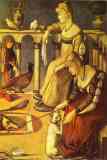Vittore Carpaccio Biography
Neither the date of Capriccio's birth nor the date of his death are known precisely. This master was born in Venice c. 1455/60. His first known works, however, do not appear until 1490, the date on one of the canvases in the cycle illustrating the Legend of Saint Ursula for the Scuola di S. Orsola. The cycle was completed by 1495; the life and times of the saint are used as a pretext for an imaginary reconstruction of the 15th century Venice. This most famous group of paintings by Carpaccio with crowds of people in exquisite clothes and wonderful architecture in the background evokes the magical charm of the city. In these works “the probable influences of his training (Gentile Bellini’s feeling for narrative, Antonello da Messina’s sense of space, Alvise Vivarini’s precise use of light, the clear-cut graphics of the Ferrarese) appear to have been superseded by a style that is increasingly confident and personal.” (Carpaccio. By Stefano Zuffi. Electa, Italy. 1996)
Between 1502 and 1507 Carpaccio worked on a cycle of canvases for the Scuola di S.Giorgio degli Schiavoni, with the story of St. George and the dragon and episodes from the life of St. Jerome.
Between 1511 and 1514 he executed the paintings based on the life of St. Stephen in the Scuola di S. Stefano. Carpaccio also received a number of commissions from Venice's government, but after his altarpiece for the church of S. Vitale, his Venetian career foundered, partly because by then Titian dominated the scene.
Carpaccio ended his career back in the provinces (Bergamo, Cadore, Istria) where his now out-dated style still attracted admirers. He was forgotten for many centuries to come to be rediscovered in the 19th century. Now Carpaccio ranks second only to Giovanni Bellini among Venetian fifteenth-century artists.
Bibliography
Carpaccio (Library of the Great Masters). by Francesco Valcanover, Lisa Pelleti (Translator). Riverside Book Company;
May 1990.
The Art of the Italian Renaissance. Edited by Rolf Toman. Könemann. 1995.
Venice. Art and Architecture. Edited by Giandomenico Romanelli. Könneman. 1997.
Carpaccio: The Major Pictorial Cycles by Stefania Mason Rinaldi, Andrew Ellis (Translator). Skira, 2000.
Venetian Narrative Painting in the Age of Carpaccio by Patricia Fortini Brown. Yale Univ Pr, 1990.
Carpaccio by Vittorio Sgarbi. Abbeville Press, Inc., 1995.
- Two Court Ladies.

c.1490. Panel. 94 x 64 cm. Museo Correr, Venice, Italy.
- Two Court Ladies. Detail.

c. 1490. Oil on panel. 94 x 64 cm. Museo Correr, Venice, Italy.